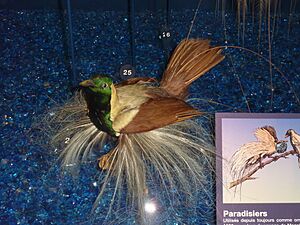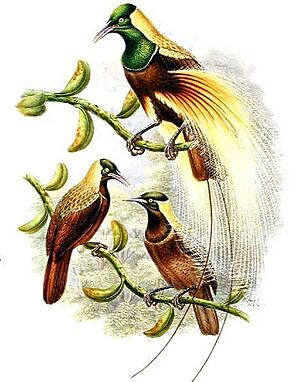Emperor bird-of-paradise facts for kids
Quick facts for kids Emperor bird-of-paradise |
|
|---|---|
 |
|
| Male (taxidermy mount) | |
| Conservation status | |
| Scientific classification | |
| Genus: |
Paradisaea
|
| Species: |
guilielmi
|
The Emperor Bird-of-Paradise is a beautiful type of bird-of-paradise. Its scientific name is Paradisaea guilielmi. It is also sometimes called the Emperor of Germany's Bird-of-Paradise.
This amazing bird lives only in Papua New Guinea. You can find it in the hill forests of the Huon Peninsula. It mostly eats fruits, especially figs. It also enjoys small creatures like arthropods (think insects and spiders).
The bird gets its name from Wilhelm II of Germany. He was the last Emperor of Germany and King of Prussia. In January 1888, a explorer named Carl Hunstein discovered this bird. It was the last bird-of-paradise to be found. Carl Hunstein also found the blue bird-of-paradise on his trips.
The Emperor Bird-of-Paradise is special. It is one of only three Paradisaea species that do an "inverted display." This means the male bird hangs upside down to show off its beautiful feathers.
Sadly, the Emperor Bird-of-Paradise is considered Near Threatened. This is because its home is shrinking. Also, people hunt them in some areas. It is listed on Appendix II of CITES. This means it is protected from too much international trade.
What Does the Emperor Bird-of-Paradise Look Like?
The Emperor Bird-of-Paradise is a large bird. It is about 33 centimeters (13 inches) long. Its body is yellow and brown. It has reddish-brown eyes and a bluish-grey bill. Its legs are purplish-brown.
The male bird is very striking. It has a dark emerald green face and throat. It also has two very long tail wires. These are like thin, long feathers that stick out from its tail. The male also has large white feathers on its sides. These are called ornamental flank plumes. They are used to attract females.
The female bird looks a bit like the male. However, she is all brown. She is also smaller than the male. Most importantly, she does not have the fancy ornamental plumes or the long tail wires.



